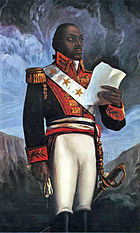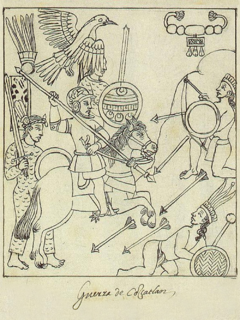History
Records show that in 1521, Lucas Vázquez de Ayllón, a wealthy sugar planter on Española (Hispaniola) and oidor (judge) of the royal Audencia of Santa Domingo, dispatched Francisco Gordillo northward to explore the North American continent. [5] Gordillo sailed north from Hispaniola through the Bahamas, where near the island of Lucayoneque he fell in with a caravel commanded by slave raider Pedro de Quexos (Pedro de Quejo). He was a relative of Gordillo's pilot Alonzo Fernández Sotil. [6] They joined forces and continued to the coast of present-day South Carolina, sailed into Winyah Bay just north of the mouth of the South Santee River. [5]

Hispaniola is an island in the Caribbean island group known as the Greater Antilles. It is the second largest island in the Caribbean after Cuba, and the most populous island in the Caribbean; it is also the eleventh most populous island in the world.

The caravel was a small, highly maneuverable sailing ship developed in the 15th century by the Portuguese to explore along the West African coast and into the Atlantic Ocean. The lateen sails gave it speed and the capacity for sailing windward (beating). Caravels were used by the Portuguese and Castilians (Spain) for the oceanic exploration voyages during the 15th and 16th centuries in the Age of Discovery.

Winyah Bay is a coastal estuary that is the confluence of the Waccamaw River, the Pee Dee River, the Black River, and the Sampit River in Georgetown County, in eastern South Carolina. Its name comes from the Winyaw, who used to inhabit the region during the eighteenth century. The historic port city of Georgetown is located on the bay, and the bay generally serves as the terminating point for the Grand Strand.
There they captured 70 natives to sell in Hispaniola, [7] one of whom was baptized with the name "Francisco de Chicora" [8] and later served as a translator for the Spanish. [9] [10] [11] Ayllón took the young Native American back with him to Spain and presented him to the royal court, where he recounted exaggerated stories about his homeland [12] [13] and the neighboring provinces in what is now known as the Carolinas. "Chicora" (the name the Spanish gave to the area) was one of several Siouan-speaking territories subject to the chief Datha of Duahe (also recorded in Spanish as Duhare). [14] According to the historian Paul E. Hoffman, Francisco described the people of Duhare as "white" and having "blond hair to the heels", [15] and told of a gigantic Indian king called Datha. [16] who ruled a race of giants. [17] He also recounted there was another race of men who grew long tails. [13]
Francisco de Chicora was the baptismal name given to a Native American kidnapped in 1521, along with 70 others, from near the mouth of the Pee Dee River by Spanish explorer Francisco Gordillo and slave trader Pedro de Quexos, based in Santo Domingo and the first Europeans to reach the area. From analysis of the account by Peter Martyr, court chronicler, the ethnographer John R. Swanton believed that Chicora was from a Catawban group.
Chicora was a legendary Native American kingdom or tribe sought by various European explorers in present-day South Carolina during the 16th century. The legend originated after Spanish slave traders captured an Indian they called Francisco de Chicora in 1521; afterward, they came to treat Francisco's home country as a land of abundant wealth and natural resources. The "Chicora Legend" influenced both the Spanish and the French in their attempts to colonize North America for the next 60 years.

Siouan or Siouan–Catawban is a language family of North America that is located primarily in the Great Plains, Ohio and Mississippi valleys and southeastern North America with a few other languages in the east.
In 1523, Ayllón obtained a cédula, or royal patent, from Charles V and the Council of the Indies giving him permission to explore the Atlantic coastline of Chicora and beyond. He was given exclusive rights to establish a settlement there. [18] [7] In 1525 he sent two caravels commanded by Pedro de Quexos to chart the coastline and sound its waters. [19] The slaver explored as far north as Delaware Bay. [20] De Quexos persuaded two natives from each district to return with him to Spain to learn Spanish, and thereafter act as interpreters for the colonists.
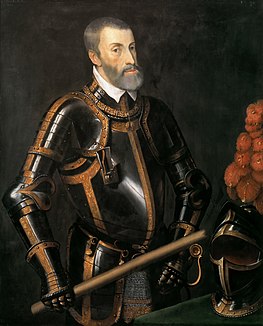
Charles V was ruler of both the Holy Roman Empire from 1519 and the Spanish Empire from 1516, as well as of the lands of the former Duchy of Burgundy from 1506. He stepped down from these and other positions by a series of abdications between 1554 and 1556. Through inheritance, he brought together under his rule extensive territories in western, central, and southern Europe, and the Spanish viceroyalties in the Americas and Asia. As a result, his domains spanned nearly 4 million square kilometres, and were the first to be described as "the empire on which the sun never sets".
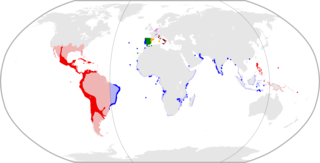
The Council of the Indies; officially, the Royal and Supreme Council of the Indies, was the most important administrative organ of the Spanish Empire for the Americas and the Philippines. The crown held absolute power over the Indies and the Council of the Indies was the administrative and advisory body for those overseas realms. It was established in 1524 by Charles V to administer "the Indies," Spain's name for its territories. Such an administrative entity, on the conciliar model of the Council of Castile, was created following the Spanish conquest of the Aztec empire in 1521, which demonstrated the importance of the Americas. Originally an itinerary council that followed Charles V, it was subsequently established as an autonomous body with legislative, executive and judicial functions by Philip II of Spain and placed in Madrid in 1561. The Council of the Indies was abolished in 1812 by the Cádiz Cortes, briefly restored in 1814 by Ferdinand VII of Spain, and definitively abolished in 1834 by the regency, acting on behalf of the four-year-old Isabella II of Spain.
In nautical terms, the word sound is used to describe the process of determining the depth of water in a tank or under a ship. Tanks are sounded to determine if they are full or empty and for other reasons. Soundings may also be taken of the water around a ship if it is in shallow water to aid in navigation.
By mid-July 1526, Ayllón had organized an expedition of 600 settlers and 100 horses to found a colony. He lost one of his three ships in the river that Capt. Quexos had named the Rio Jordan; whether it was the Santee [21] or the Cape Fear River [22] is still debated by scholars. [23] The remainder of the expedition landed in Winyah Bay, near the site of present-day Georgetown, South Carolina, on 29 September (the "Feast of Archangels"). Francisco de Chicora left and escaped into the woods. Ayllón's party proceeded 40 or 45 leagues, partly overland and partly by boat, visiting the "king" of Duahe en route, according to expedition historian Peter Martyr.
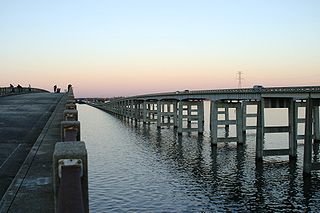
The Santee River is a river in South Carolina in the United States, and is 143 miles (230 km) long. The Santee and its tributaries provide the principal drainage for the coastal areas of southeastern South Carolina and navigation for the central coastal plain of South Carolina, emptying into the Atlantic Ocean approximately 440 miles (708 km) from its farthest headwater on the Catawba River in North Carolina. The Santee River is the second largest river on the eastern coast of the United States, second only to the Susquehanna River in drainage area and flow. Much of the upper river is impounded by the expansive, horn-shaped Lake Marion reservoir, formed by the 8-mile (13 km)-long Santee Dam. The dam was built during the Great Depression of the 1930s as a Works Progress Administration (WPA) project to provide a major source of hydroelectric power for the state of South Carolina.

The Cape Fear River is a 202-mile (325 km) long blackwater river in east central North Carolina in the United States. It flows into the Atlantic Ocean near Cape Fear, from which it takes its name.

Georgetown is the third oldest city in the U.S. state of South Carolina and the county seat of Georgetown County, in the Lowcountry. As of the 2010 census it had a population of 9,163. Located on Winyah Bay at the confluence of the Black, Great Pee Dee, Waccamaw, and Sampit rivers, Georgetown is the second largest seaport in South Carolina, handling over 960,000 tons of materials a year.
In early October, they reached another river, which they named the Guadalupe, where they founded the mission San Miguel de Guadalupe. Scholars have disputed the location of this colony, since the expedition did not relate in which direction they traveled from the Jordan (Santee). Some historians have asserted that Ayllón went north, reaching the Chesapeake Bay. Francisco Fernández de Écija, chief pilot of Spaniards searching the Chesapeake Bay for English activities in 1609, [24] claimed that Ayllón in 1526 had landed on the James River somewhere near where Jamestown was later developed. [25] Écija also claimed the natives at the Santee had told him Daxe (Duahe) was a town 4 days to the north.
The 20th-century American ethnologist John Swanton, who studied the southeastern Indian tribes, suggested Ayllón may have gone 45 leagues to the southwest, and that the "Guadalupe" was the Savannah River in present-day Georgia. There the expedition would have interacted with the Guale, a chiefdom that was part of the Mississippian culture. [26]
Since the early 21st century, contemporary American scholars concur that Ayllón probably developed the 1526 settlement at or near present-day Georgia's Sapelo Island. They believe that scholarly speculation suggesting that the San Miguel settlement (Tierra de Ayllón) was founded any farther to the north cannot be substantiated. [27] Archaeological attempts to locate the site have so far been unsuccessful. [28]
The colony was a failure. Ayllón died in October 1526, [3] purportedly in the arms of a Dominican friar. Two-thirds of the settlers died before the three months of severe winter ended, [1] suffering from the scarcity of supplies, hunger, malaria and other diseases. [1] A mutiny took place after Ayllón's death, with some men mistreating the local natives, who attacked the settlers. [3] The mutiny was quelled but problems continued. In the spring of 1527, Francis Gomez sailed two vessels, holding some 150-200 survivors, to Hispaniola. One ship sank on the way, requiring survivors to crowd on the single vessel to reach the island. [29]
Slavery and rebellion
Together with hundreds of settlers, Ayllón had brought a group of roughly 100 "seasoned", enslaved Africans and natives from Hispaniola [30] to labor at the mission, to clear ground and erect the buildings. After Ayllón's death, some of the settlers mutinied against his successor. They mistreated the local Guale people and the enslaved Africans. The natives attacked the settlers and the enslaved Africans rebelled, many of them escaping to take refuge in Guale settlements. [31] This 1526 incident is regarded as the first documented slave rebellion in North America, and the surviving enslaved Africans are considered the first non-native settlers. [4]
First Catholic mass in the United States
Dominican friars Fr. Antonio de Montesinos and Fr. Anthony de Cervantes were among the colonists at San Miguel de Guadalupe. They would have celebrated mass each day, making this the first place in the present-day United States in which mass was celebrated. The specific location and date of the event are not known. [32]
